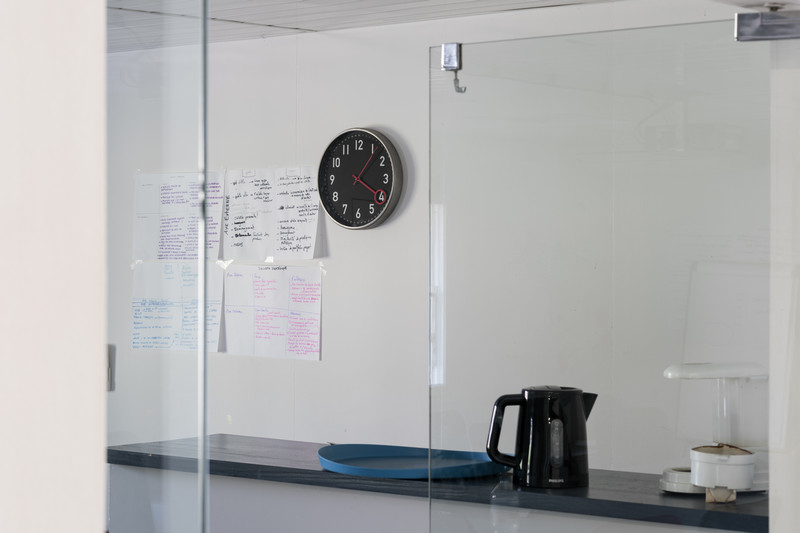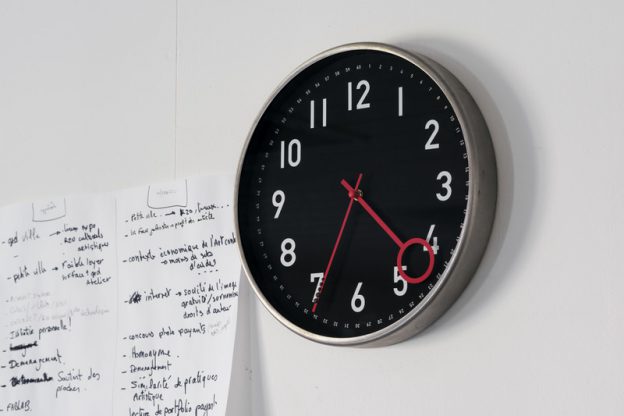2019
Wall clock, fishing lead.
Horloge lestée (Weighted clock) is a piece in which an alteration is made to the mechanism of the clock in the BBB art centre training room in Toulouse. The building occupied by the art centre was previously a factory producing electric coil, a historical background that puts the clock within a context symbolising worker exploitation and the struggles and demands that were part of the genesis of the industrial era, the triumph of capitalism and the establishment of neoliberalism.
More precisely, Horloge lestée is an attempt to recreate a true case of manipulation of the clock at a flax spinning mill, aiming to “shorten” the sole break of 30 minutes in the 13-hour day worked at the mill by boys and girls who were barely in their teens. This case was cited in 1832 in an account given before the Committee on the. Bill to Regulate the Labour of Children in the Mills and Factories of the United Kingdom, quoted by the English historian Edward P. Thompson in Time, Work-discipline, and Industrial Capitalism: “Petty devices were used to shorten the dinner hour and to lengthen the day […] and [manufacturers]: want to nip every corner that they can, so that the bell will ring to leave off when it is half a minute past time, and they will have them in about two minutes before time … If the clock is as it used to be, the minute hand is at the weight, so that as soon as it passes the point of gravity, it drops three minutes all at once, so that it leaves them only twenty-seven minutes, instead of thirty.”
Horloge murale, plombs de pêche.
L’Horloge lestée consiste en une altération du mécanisme de l’horloge présente dans la salle de formation du BBB centre d’art, à Toulouse. Le bâtiment occupé par le centre d’art a auparavant été une usine de bobines électriques, une anecdote qui renvoie à l’histoire de l’horloge en tant qu’objet cristallisant l’exploitation patronale, les luttes et revendications ouvrières ayant accompagné la genèse de l’ère industrielle, le triomphe du capitalisme et l’accélération néolibérale.
Plus concrètement, Horloge lestée est une tentative de reconstitution d’un cas authentique de manipulation de l’horloge dans une filature à lin, visant à « compresser » les 30 minutes de l’unique pause de la journée de 13 heures des ouvriers garçons et filles à peine adolescents. Ce cas est cité en 1832 dans un témoignage devant la Commission de loi sur la régulation du travail des mineurs dans les moulins et usines du Royaume-Uni, repris par l’historien anglais Edward P. Thompson dans Temps, discipline du travail et capitalisme industriel : « Les employeurs recouraient à de sordides subterfuges pour écourter la pause du déjeuner et allonger la journée de travail […] ils cherchent à rogner sur tout ce qu’ils peuvent : la cloche annoncera la sortie trente secondes après l’heure, et le début du travail deux minutes avant l’heure… Si l’horloge est encore réglée comme elle l’était, l’aiguille des minutes est lestée, de sorte que dès qu’elle passe son point de gravité, elle tombe d’un coup de trois minutes, ce qui ne leur laisse plus que 27 minutes au lieu de 30. ” »

